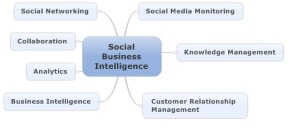Post written by Niaz T., Senior Solution Architect/SAP BW Consultant at Ideaca. Read more about SAP HANA on her blog: Discover In-memory Technology.
In the world of technology there are a
hundred definitions for “Big Data.” It seems confusing to come up with a single
definition when there is a lack of standard definition. Like many other terms
in technology, Big Data has evolved and matured and so has its definition. Depending
on who we ask and what industry/business field they’re in, we will get
different definitions. Timo Elliott summarized some of the more popular
definitions of Big Data in “7
Definitions of Big Data You Should Know About.”
You may be familiar with three “V’s”
or the classic 3V
model. However, this original definition does not fully describe the
benefits of Big Data. Recently, it has been suggested to add 2 more V’s to the
list such as Value and Verification or Veracity which are resulted from “Data
Management Practices.” As a BI expert who is been involved in Big Data, my
approach is to have a practical definition for my clients by emphasizing the main
characteristics of data and purpose of Big Data related to each specific area. I
like Gartner’s concise definition. Gartner defined Volume, Velocity and Variety
characteristics of information assets as not 3 parts but one part of Big Data
definition.
Big data is high-volume, high-velocity
and high-variety information asset that demands cost-effective, innovative
forms of information processing for enhanced insight and decision making.
(Gartner’s definition of big data)
The second part of the definition
addresses the challenges we face to take the best of infrastructure and technology capabilities. Usually these types of
solutions are expensive and clients expect to have cost effective and
appropriate solution to answer their requirement. In my opinion this covers the
other V which is related to how we implement Data Management Practices in Big
Data Architecture Framework and its Lifecycle Model.
The third part covers the most
important part and ultimate goal which is Value.
Business value is in the insight to their data and to react to this insight to
make better decisions. To have a right vision, it’s important to understand,
identify and formulate business problems and objectives knowing practical Big
Data solutions are feasible but not easy. So when I define Big Data for my
clients, I use Gartner’s definition and explain the journey we need to take
together to achieve their goal.
In any Big Data project, I start with
BDAF or Big Data Architecture Framework which consists of Data Models, Data
Lifecycle, Infrastructure, Analytic tools, Application, Management Operation
and Security. One of the key components is having high performance computing
storage. Since Big Data technologies are evolving and there more options to be
considered, I’m focusing on SAP HANA capabilities which enable us to design
practical and more cost effective solutions. HANA could be one part of overall
Big Data Architecture Framework but it’s the most essential part. The beauty
behind SAP HANA is that it is not just a powerhouse Database but it is a
development platform to provide real time platform for both analytics and the
transactional systems. It enables us to move beyond traditional data
warehousing and spending significant time on data extraction and loading. In
addition we’re able to take advantage of hybrid processing to design more
advance modeling. Another big advantage of HANA is the capability of integrate
it with SAP and non-SAP tools.
So, why am I so excited about it?
Looking around I see tons of opportunities and brilliant ideas which could get
off the ground with some funding. So far, HANA has been more successful in
large enterprises with big budgets and larger IT staff. However I’m also
interested to encourage medium size enterprises to see the potential of HANA to
provide a solution for their problems. The majority of businesses don’t spend
their budget to develop a solution. They are eager to pay to solve a particular
problem. Now, our challenge as SAP consultants is to help businesses see this
potential and how HANA can address their challenges. The good news is SAP
supports by providing test environment and development licenses for promising
startups.
Got your attention? Well, just to give
you a glimpse, take a look at some of the success
stories. In addition there are many many other cases if we look around. For
instance, these days many applications capture Geo-location data like trucking
company, transportation, etc. it means capturing data every 10 seconds or so
from every section, every piece of equipment, every location. This could add up
to a Petabyte of data! This is an excellent way to bring insight into data and
drive intelligence out of it and have it circulated back to scheduling and
movement processes. Another example could be companies needing to mine
information from social media regarding to their products and connecting this intelligence
back to their back end processes to increase customer engagement and
satisfaction.











